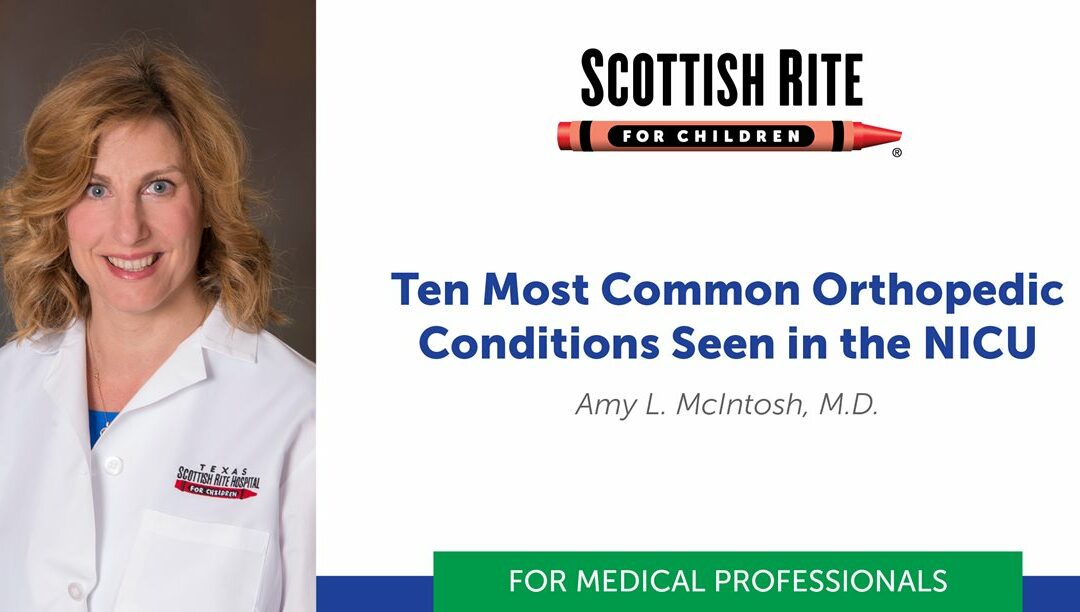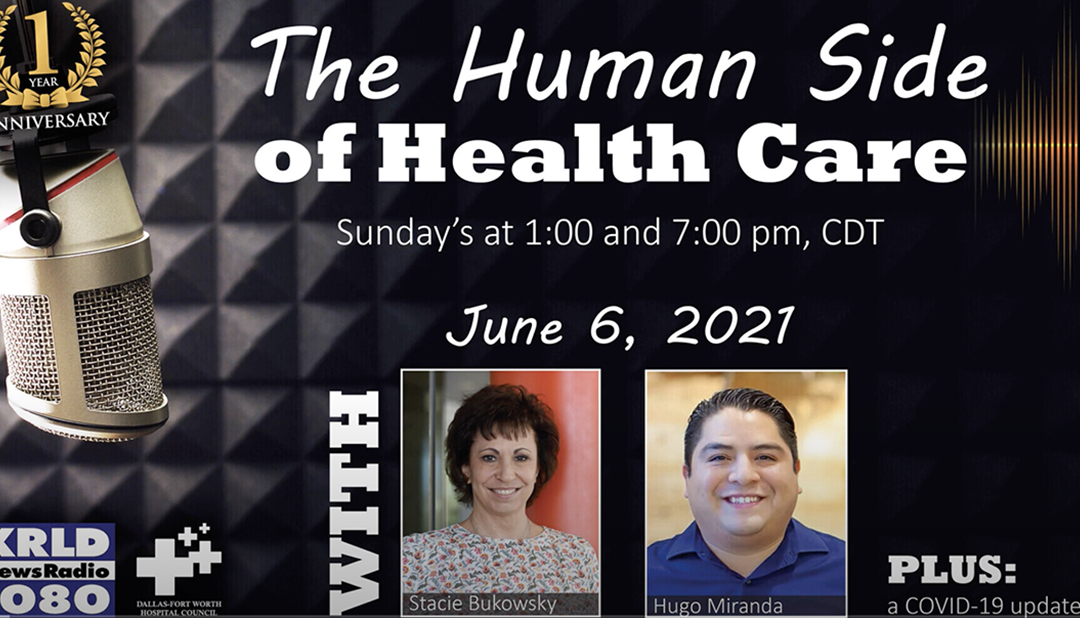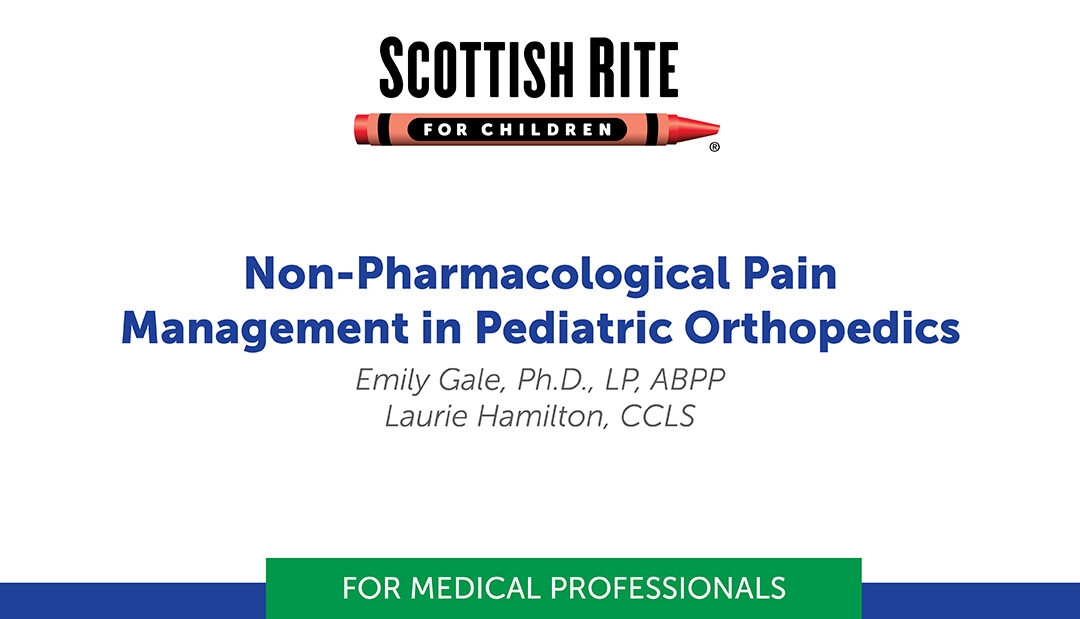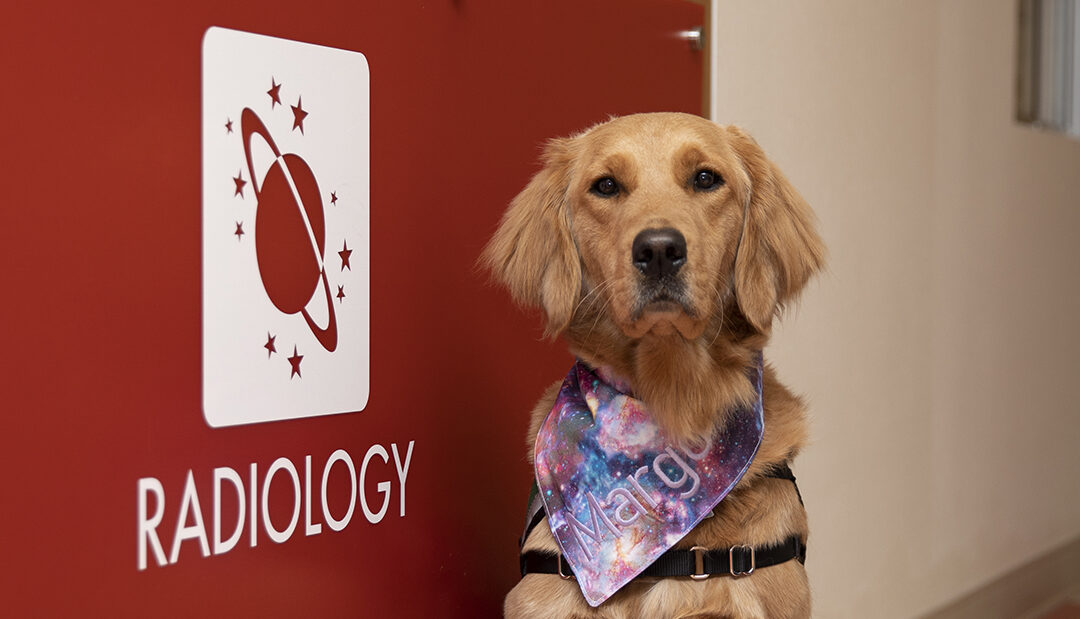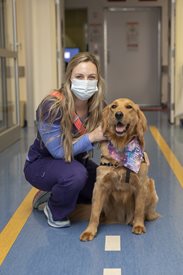Content included below was presented at the 2021 Pediatric Orthopedic Education Symposium by pediatric orthopedic surgeon Amy L. McIntosh, M.D.
Watch the full lecture or download this summary.
Newborn care, particularly in the neonatal intensive care unit (NICU) requires the consultation of many pediatric specialists. Scottish Rite for Children pediatric orthopedic surgeon Amy L. McIntosh, M.D., frequently consults in the NICU, and in a lecture for pediatricians and other health care providers, she summarized the ten most common conditions she evaluates in newborns.
Pseudoparalysis
A baby with pseudoparalysis typically presents with one arm laying or hanging limply. In many cases, the hand of the affected limb moves normally and the baby can successfully grasp and release the fingers and thumb.
A mechanical injury, typically during birth, causes the apparent paralysis. These factors may contribute to pseudoparalysis:
- Vaginal delivery
- Large baby
- Delivery converted from vaginal to C-section due to the size of the baby
- Maternal diabetes
- Forceps-assisted delivery
The most common causes for pseudoparalysis are:
Fracture to the clavicle or humerus
Though alarming to the parents, these causes of pseudoparalysis typically have excellent outcomes. Treatment is focused on immobilizing the arm and keeping the child comfortable, and follow-up care is minimal. In fact, repeating X-rays in follow-up is unnecessary and not recommended.
The treatment instructions are simple. Put the baby in a long-sleeved onesie and safety pin the sleeve to the torso of the onesie for two weeks. This is the easiest way to immobilize the arm. Tylenol may be given to the baby for any pain.
Injury to the Brachial Plexus
The brachial plexus provides motor control in the arm and fingers. Stretching or tearing of a portion of these nerves can cause true paralysis. The child’s wrist and fingers are held in flexion, and there is no active extension with them. When diagnosed, a pediatric hand specialist will often recommend occupational therapy to teach the parents arm, wrist and finger exercises. Observation for nerve recovery and continued care with a pediatric orthopedic hand/upper extremity specialist is highly recommended.
Developmental Dysplasia of the Hip (DDH)
Developmental dysplasia of the hip (DDH) is an orthopedic condition in which the hip joint is unstable or has a shallow socket. There are several risk factors to consider at the beginning of the consultation including:
- Firstborn
- Female
- Family history of hip dysplasia
- Breech delivery
- Significantly low amount of amniotic fluid
During the exam, a Barlow maneuver will replicate the hip dislocation, and an Ortolani maneuver moves the femoral head back into the socket. To visualize the condition of the joint surfaces and shape, ultrasound is used to aid in treatment planning. The treatment for DDH is to position the hips in a “frog leg” posture for 23 hours / day using a Pavlik harness for a period of 6-12 weeks. The earlier treatment begins, the better the outcome. Though treatment is typically successful, annual observation by the pediatric orthopedic specialist is recommended until the patient is 18 years old.
Clubfoot
Clubfoot is a congenital disorder in which the foot is severely turned inward and pointed downward. Clubfoot is often associated with other syndromes, including arthrogryposis and amniotic band syndrome. The majority of clubfeet are easily seen on the prenatal ultrasound that is done at 20-26 weeks gestation. During the prenatal consult, Scottish Rite pediatric orthopedic surgeons explain what clubfoot is and its treatment. The Ponseti method is a series of weekly casts that gently move the foot into the correct position. If the baby is going to be in the NICU for six weeks or more, the entire Ponseti method can be completed in the NICU. Otherwise, treatment can begin after discharge from the NICU.
Amniotic band syndrome (Streeter’s dysplasia)
Amniotic band syndrome is a condition where amniotic bands formed in utero constrict fingers, limbs and other body parts. When clubfoot is related to amniotic band syndrome, it is called Streeter’s dysplasia. Sometimes the constriction from amniotic bands requires the limb to be amputated. To establish a relationship and initiate a prosthetic tolerance program and plan, the pediatric orthopedist collaborates with pediatric prosthetists. At a developmentally appropriate time, a custom prosthesis is created to assist the child in meeting normal developmental milestones on time.
NOT Amniotic band syndrome or compartment syndrome –> Limb Ischemia with dry gangrene and auto-amputation
In extremely rare occasions when intrauterine fetoscopic laser surgery is done to treat twin-to-twin transfusion syndrome (TTTS), a loss of blood supply to the developing extremities may cause ischemia and necrosis of a limb or limbs. In these cases, a pediatric orthopedic surgeon monitors and supports efforts to prevent infection while awaiting an autoamputation to occur. Establishing an early connection with a pediatric prosthetist ensures timely training and care to protect normal developmental progression.
Polydactyly / Syndactyly
Polydactyly is a hereditary condition that causes supernumerary (excess) fingers and/or toes, typically on the medial or lateral side. Syndactyly is a condition that causes two or more digits to be fused together. With preaxial polydactyly, the thumb or great toe (first digit, or medial-sided) is duplicated, which can be associated with tibial dysplasia or a tibial hemimelia. It is important to get X-rays of the tibia, fibula and foot to fully assess for tibial dysplasia. With postaxial polydactyly, the fifth, most lateral digit is duplicated. Postaxial polydactyly is never associated with tibial hemimelia, and it is much easier to treat surgically. Surgery is typically offered at 6 months of age or greater. Referral to a pediatric orthopedic surgeon for a thorough evaluation and discussion of treatment considerations is highly recommended.
Congenital knee dislocation
Congenital knee dislocation (CKD) is often associated with other syndromes, so a genetic consult is indicated. These babies are usually born Frank breech, and some may have required a Cesarean delivery. The knee or knees present in a hyperextended position. Ultrasound should be used to rule out hip dislocations, since the knee and hip are often both affected. CKD is treated with serial casting. A series of long leg plaster casts will slowly reduce the knee joint into a more normal position. Once the knee can be flexed to 90 degrees, a Pavlik harness is used to maintain knee flexion. Treatment can be completed during the NICU stay or as outpatient procedures after discharge.
Calcaneovalgus foot
Unlike a clubfoot, with a calcaneovalgus foot, the calcaneus is dramatically everted and flexed, sometimes the top of the foot is almost touching the tibia. This condition is usually caused by intrauterine positioning. With appropriate stretching, the foot position gradually improves in the first 4 to 6 weeks of life.
There is an association between calcaneovalgus feet and posteromedial bowing of the tibia. When an X-ray of the tibia reveals or confirms a posteromedial bow, the child is very likely to have a leg length discrepancy of 2-5 centimeters. These children should be referred to a pediatric orthopedic specialist with experience in limb reconstruction to monitor, and if needed, address the leg length discrepancy caused by the tibia bowing prior to skeletal maturity.
Spinal dysraphism
Spinal dysraphism is a reference to congenital abnormalities in the vertebrae, spinal cord and/or nerve roots. These signs are commonly associated with underlying spinal abnormality:
- Hairy patch on the midline of the back
- Central, sacral dimple
- Abnormal fat distribution in the lumbosacral area
These cutaneous manifestations are all significant hints that the underlying spinal cord or vertebrae did not form normally. An MRI of the spine is required to determine the exact nature of the spinal dysraphism. Possible definitive diagnoses include tethered cord, abnormal development of the spinal cord, lipomeningocele or spina bifida. Referral to a pediatric orthopedic specialist with experience in neurological and spine conditions is highly recommended. The child will need ongoing evaluation and intervention to maximize function with spine and limb deformities with growth.
Addressing positioning, postural and orthopedic concerns may not be a top priority in the early days, but consulting a pediatric orthopedic specialist should be considered as soon as the need is identified. A collaborative approach to prioritizing care with treatment plans and accurate information is beneficial for treatment outcomes and reassuring to the family.

